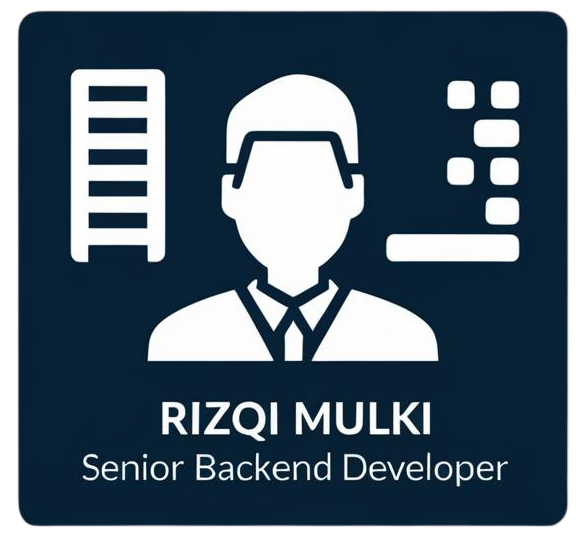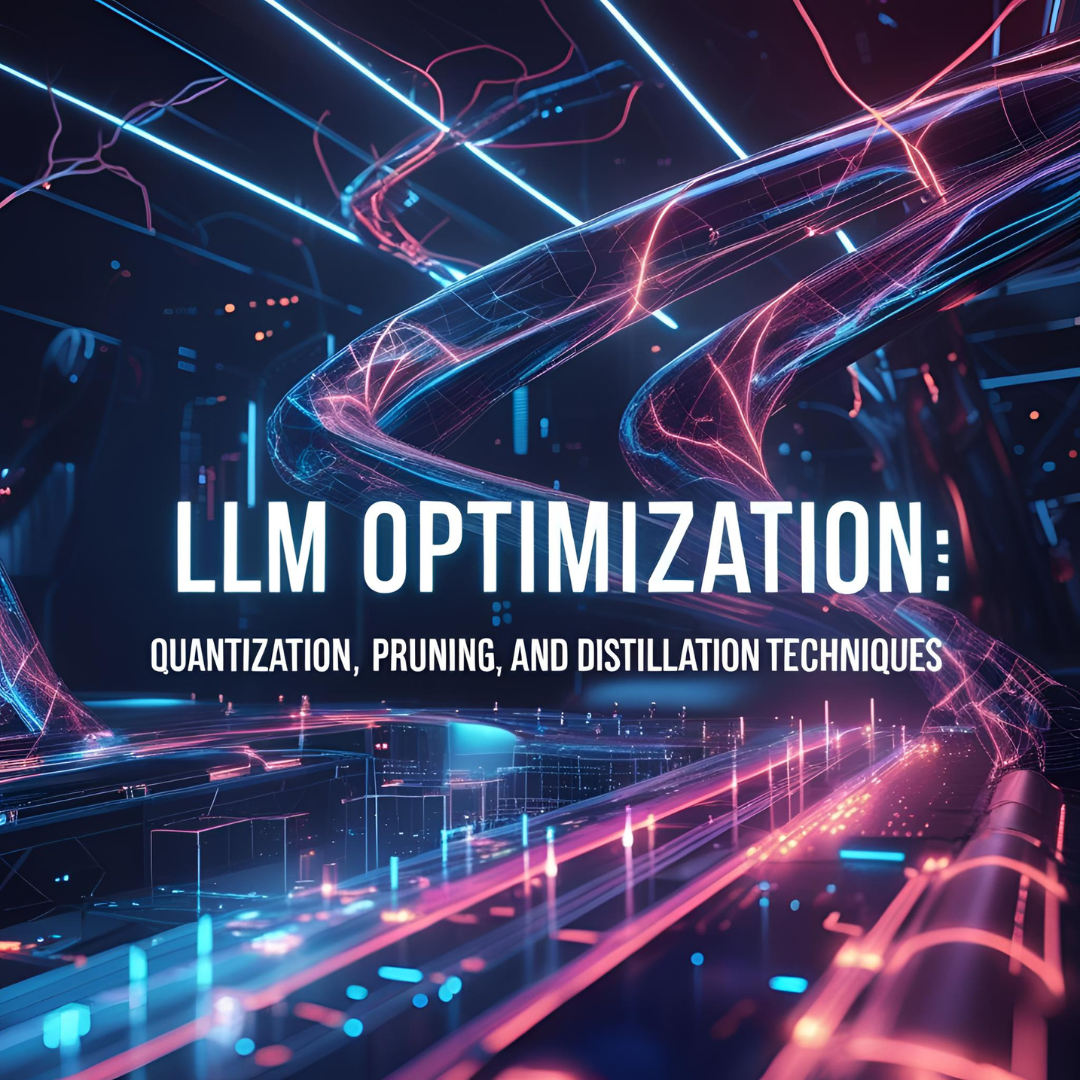As Large Language Models (LLMs) continue to grow in size and capability, the need for optimization techniques becomes increasingly critical. This comprehensive guide explores three fundamental approaches to LLM optimization: quantization, pruning, and knowledge distillation. These techniques enable deployment of powerful language models in resource-constrained environments while maintaining acceptable performance levels.
The Optimization Imperative
Modern LLMs face significant deployment challenges due to their massive parameter counts and computational requirements. A typical 7B parameter model requires approximately 14GB of memory in FP16 precision, making deployment on consumer hardware challenging. Optimization techniques address these challenges by reducing model size, computational complexity, and memory requirements while preserving as much performance as possible.
Quantization: Precision Reduction Strategies
Fundamentals of Quantization
Quantization reduces the numerical precision of model weights and activations, typically from 32-bit or 16-bit floating-point to lower bit-width representations. This technique can dramatically reduce memory footprint and computational requirements with carefully managed precision loss.
Post-Training Quantization (PTQ) applies quantization after model training is complete. This approach is straightforward to implement and doesn’t require access to the original training data or computational resources needed for retraining.
Quantization-Aware Training (QAT) incorporates quantization effects during the training process, allowing the model to adapt to reduced precision. While more complex to implement, QAT typically achieves better performance than PTQ, especially at very low bit-widths.
Quantization Strategies
Uniform Quantization maps floating-point values to discrete levels using linear scaling. The quantization function typically follows: q = round((x - zero_point) / scale), where scale and zero_point are calibration parameters determined from the data distribution.
Non-Uniform Quantization uses non-linear mapping to better capture the distribution of weights and activations. Techniques like k-means clustering or learned quantization levels can provide better approximation of the original distribution.
Dynamic vs Static Quantization: Dynamic quantization calculates scaling factors at runtime based on actual activation values, providing better accuracy but with computational overhead. Static quantization pre-calculates these factors, offering better performance at the cost of potential accuracy degradation.
Advanced Quantization Techniques
Mixed-Precision Quantization applies different bit-widths to different layers or components based on their sensitivity to quantization. Attention layers, which are typically more sensitive, might use higher precision while feed-forward layers use lower precision.
Group-wise Quantization partitions weights into groups and applies separate quantization parameters to each group. This approach can better capture local variations in weight distributions, particularly effective for transformer architectures.
Outlier-Aware Quantization identifies and handles extreme values that can skew quantization parameters. Techniques like SmoothQuant redistribute outliers from activations to weights, making both more amenable to quantization.
Pruning: Structural Simplification
Pruning Fundamentals
Pruning removes unnecessary parameters or components from neural networks, reducing model size and computational requirements. The challenge lies in identifying which components can be removed with minimal impact on performance.
Magnitude-Based Pruning removes weights with the smallest absolute values, based on the assumption that smaller weights contribute less to model output. While simple, this approach doesn’t account for the cumulative effect of many small weights.
Gradient-Based Pruning uses gradient information to estimate parameter importance. Parameters with consistently small gradients during training are considered less important and can be pruned.
Structured vs Unstructured Pruning
Unstructured Pruning removes individual weights regardless of their position in the network structure. While this can achieve high sparsity levels, it requires specialized hardware or software to realize actual speedup benefits.
Structured Pruning removes entire structural components like attention heads, feed-forward network dimensions, or entire layers. This approach provides immediate computational benefits on standard hardware but may require more careful selection to maintain performance.
Semi-Structured Pruning follows patterns like N:M sparsity (N zeros out of every M consecutive elements), providing a balance between flexibility and hardware efficiency. Modern GPUs increasingly support these patterns natively.
LLM-Specific Pruning Strategies
Attention Head Pruning systematically removes less important attention heads based on metrics like attention entropy or downstream task performance. Research shows that many attention heads can be removed with minimal impact on performance.
Layer Pruning removes entire transformer layers, typically from the middle of the network where representations are most redundant. This provides significant computational savings but requires careful validation to maintain performance.
Token Pruning dynamically removes less important tokens during computation, reducing the effective sequence length. This approach is particularly effective for longer sequences where not all tokens contribute equally to the final output.
Knowledge Distillation: Capability Transfer
Distillation Principles
Knowledge Distillation transfers knowledge from a large, complex “teacher” model to a smaller, more efficient “student” model. The student learns to mimic the teacher’s behavior while using significantly fewer parameters.
Response-Based Distillation trains the student to match the teacher’s output distributions. For language models, this typically involves matching the probability distributions over the vocabulary for each position in the sequence.
Feature-Based Distillation aligns intermediate representations between teacher and student models. This approach can provide richer supervision by matching hidden states, attention patterns, or other internal features.
Advanced Distillation Techniques
Progressive Distillation gradually reduces model size through multiple distillation stages, each with a smaller student than the previous. This staged approach often achieves better final performance than direct distillation to the target size.
Task-Specific Distillation tailors the distillation process for specific downstream tasks rather than general language modeling. This focused approach can achieve better task performance with smaller models.
Self-Distillation uses the model as both teacher and student, typically by having earlier layers predict the outputs of later layers. This technique can improve model efficiency without requiring a separate teacher model.
Distillation for LLMs
Sequence-Level Distillation matches the complete sequence generation behavior between teacher and student models. This approach is particularly important for autoregressive language models where token-by-token decisions compound.
Attention Transfer explicitly matches attention patterns between teacher and student models, helping the student learn which parts of the input to focus on. This is especially valuable for tasks requiring complex reasoning or long-range dependencies.
Capability-Specific Distillation focuses on transferring specific capabilities like mathematical reasoning, code generation, or factual knowledge. This targeted approach can maintain critical capabilities in smaller models.
Combining Optimization Techniques
Sequential Application
Quantization after Pruning first removes unnecessary parameters through pruning, then quantizes the remaining weights. This approach can achieve very high compression ratios but requires careful calibration to maintain performance.
Distillation followed by Quantization creates a smaller model through distillation, then applies quantization for further compression. This sequence often provides better final performance than applying techniques in reverse order.
Joint Optimization
Differentiable Neural Architecture Search (DNAS) simultaneously optimizes model architecture, quantization strategies, and pruning decisions through gradient-based methods. While computationally intensive, this approach can find better optimization configurations.
Multi-Objective Optimization explicitly balances multiple objectives like model size, inference speed, and accuracy using techniques like Pareto optimization. This approach helps identify the best trade-offs for specific deployment scenarios.
Implementation Considerations
Hardware-Aware Optimization
Target Platform Characteristics: Different hardware platforms have varying capabilities for handling quantized operations, sparse computations, and memory hierarchies. Optimization strategies should be tailored to the target deployment environment.
Memory Bandwidth Limitations: Many deployment scenarios are memory-bandwidth limited rather than compute-limited. Techniques that reduce memory access, like weight quantization, can provide significant speedup even without reducing computation.
Calibration and Validation
Calibration Dataset Selection: Post-training quantization and pruning require representative calibration data. The choice of calibration dataset can significantly impact the final model performance.
Comprehensive Evaluation: Optimization can affect different capabilities differently. Evaluation should cover various tasks, not just perplexity or a single benchmark, to ensure broad capability preservation.
Production Deployment
Model Serving Optimization: Optimized models may require specialized serving infrastructure to realize full benefits. Quantized models need appropriate inference engines, while pruned models may need custom kernels.
Dynamic Loading Strategies: For very large models, techniques like parameter streaming or progressive loading can enable deployment on resource-constrained systems by loading only necessary components.
Performance Trade-offs and Considerations
Accuracy Preservation
Capability Degradation Patterns: Different optimization techniques affect various model capabilities differently. Mathematical reasoning and factual recall may be more sensitive to optimization than general language understanding.
Downstream Task Impact: The effect of optimization can vary significantly across different downstream tasks. Critical applications may require task-specific validation and potentially different optimization strategies.
Efficiency Gains
Theoretical vs Practical Speedup: Theoretical improvements from optimization techniques don’t always translate to practical speedup due to hardware limitations, software overhead, and memory access patterns.
Batch Size Dependencies: The effectiveness of different optimization techniques can vary with batch size. Some techniques are more beneficial for single-sample inference, while others provide greater benefits for batch processing.
Future Directions and Emerging Techniques
Novel Quantization Approaches
Learned Quantization: Machine learning approaches to determine optimal quantization strategies, including learned quantization functions and adaptive bit-width allocation.
Hardware-Software Co-design: Quantization techniques designed specifically for emerging hardware architectures, including neuromorphic chips and specialized AI accelerators.
Advanced Pruning Methods
Neural Architecture Search for Pruning: Automated discovery of optimal pruning patterns using reinforcement learning or evolutionary algorithms.
Dynamic Pruning: Runtime adaptation of model structure based on input complexity or available computational resources.
Next-Generation Distillation
Multimodal Distillation: Extending distillation techniques to models that handle multiple modalities, preserving cross-modal understanding in smaller models.
Continual Distillation: Techniques for continuously updating smaller models as larger models are improved, maintaining performance while preserving efficiency gains.
Practical Guidelines and Best Practices
Optimization Strategy Selection
Choose optimization techniques based on deployment constraints and performance requirements. Memory-constrained environments benefit most from quantization, while compute-constrained scenarios may prefer pruning or distillation.
Implementation Roadmap
Start with post-training techniques for quick wins, then consider more advanced methods if additional optimization is needed. Validate each step thoroughly before proceeding to more aggressive optimization.
Monitoring and Maintenance
Continuously monitor optimized models in production for performance degradation or unexpected behavior. Maintain the ability to fall back to less optimized versions if issues arise.
Conclusion
LLM optimization through quantization, pruning, and distillation techniques is essential for democratizing access to powerful language models. Each technique offers unique advantages and trade-offs, and the optimal approach depends on specific deployment requirements and constraints.
The field continues to evolve rapidly, with new techniques and combinations emerging regularly. Success requires understanding the fundamental principles, carefully evaluating trade-offs, and maintaining focus on the end-user experience rather than just technical metrics.
Effective optimization enables deployment of sophisticated language capabilities in environments previously thought impossible, from mobile devices to edge computing scenarios. As these techniques mature, they will play an increasingly important role in making advanced AI accessible to a broader range of applications and users.
This guide provides a foundation for understanding and implementing LLM optimization techniques, but specific implementations should be thoroughly tested and validated for each use case and deployment scenario.


Leave a Reply